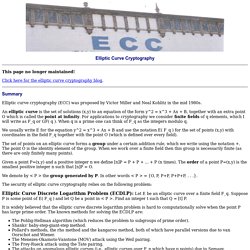

Elliptic Curve Cryptography: a gentle introduction. Those of you who know what public-key cryptography is may have already heard of ECC, ECDH or ECDSA.

The first is an acronym for Elliptic Curve Cryptography, the others are names for algorithms based on it. Today, we can find elliptic curves cryptosystems in TLS, PGP and SSH, which are just three of the main technologies on which the modern web and IT world are based. Not to mention Bitcoin and other cryptocurrencies. Before ECC become popular, almost all public-key algorithms were based on RSA, DSA, and DH, alternative cryptosystems based on modular arithmetic.
RSA and friends are still very important today, and often are used alongside ECC. With a series of blog posts I’m going to give you a gentle introduction to the world of elliptic curve cryptography. Specifically, here are the topics I’ll touch: Ready? First of all: what is an elliptic curve? Depending on the value of a and b, elliptic curves may assume different shapes on the plane. If we add a fifth requirement: So far, so great. Ieeefinal.pdf. A (Relatively Easy To Understand) Primer on Elliptic Curve Cryptography. Elliptic Curve Cryptography (ECC) is one of the most powerful but least understood types of cryptography in wide use today.

At CloudFlare, we make extensive use of ECC to secure everything from our customers' HTTPS connections to how we pass data between our data centers. Fundamentally, we believe it's important to be able to understand the technology behind any security system in order to trust it. To that end, we looked around to find a good, relatively easy-to-understand primer on ECC in order to share with our users.
Finding none, we decided to write one ourselves. That is what follows. Be warned: this is a complicated subject and it's not possible to boil down to a pithy blog post. The dawn of public key cryptography Whitfield Diffie and Martin Hellman Modern cryptography is founded on the idea that the key that you use to encrypt your data can be made public while the key that is used to to decrypt your data can be kept private. A toy RSA algorithm Voila, we're back to 67.
A dot B = C. Download. Elliptic Curve Cryptography according to Steven Galbraith. Elliptic Curve Cryptography This page no longer maintained!

Click here for the elliptic curve cryptography blog. Summary Elliptic curve cryptography (ECC) was proposed by Victor Miller and Neal Koblitz in the mid 1980s. An elliptic curve is the set of solutions (x,y) to an equation of the form y^2 = x^3 + Ax + B, together with an extra point O which is called the point at infinity.
We usually write E for the equation y^2 = x^3 + Ax + B and use the notation E( F_q ) for the set of points (x,y) with coordinates in the field F_q together with the point O (which is defined over every field). The set of points on an elliptic curve forms a group under a certain addition rule, which we write using the notation +. Given a point P=(x,y) and a positive integer n we define [n]P = P + P + ... + P (n times). We denote by < P > the group generated by P. The security of elliptic curve cryptography relies on the following problem: News Other news: Books There are now several excellent books about ECC.
Links Back. The Case for Elliptic Curve Cryptography. Background: Over the past 30 years, public key cryptography has become a mainstay for secure communications over the Internet and throughout many other forms of communications.

It provides the foundation for both key management and digital signatures. In key management, public key cryptography is used to distribute the secret keys used in other cryptographic algorithms (e.g. DES). For digital signatures, public key cryptography is used to authenticate the origin of data and protect the integrity of that data. In their day these public key techniques revolutionized cryptography. The two noteworthy first generation public key algorithms used to secure the Internet today are known as RSA and Diffie-Hellman (DH). Both algorithms have been subject to intense scrutiny since their invention around 1975.
Since their use in cryptography was discovered in 1985, elliptic curve cryptography has also been an active area of study in academia. 6-34-139045800443-45.pdf. That's so stupid that it's not even wrong.